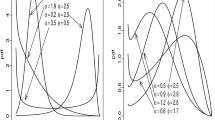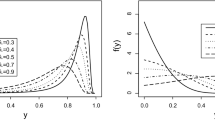Abstract
We introduce a new distribution, called the logit exponentiated power exponential, defined on the unit interval. Explicit expansions are derived for its moments. Also, we propose a regression based on this distribution with two systematic components, which can provide better fits than the beta and simplex regressions. Its parameters are estimated by maximum likelihood. Some simulations investigate the accuracy of the estimates. The usefulness of the new models is proved by means of three real data sets.






Similar content being viewed by others
References
Grassia A (1977) On a family of distributions with argument between 0 and 1 obtained by transformation of the gamma and derived compound distributions. Australian J Stat 19(2):108–114
Mitnik PA, Baek S (2013) The Kumaraswamy distribution: median-dispersion re-parameterizations for regression modeling and simulation-based estimation. Stat Pap 54(1):177–192
Jodrá P (2018) A bounded distribution derived from the shifted gompertz law. J King Saud University-Sci 32(1):523–536
Cordeiro GM, Brito RS (2012) The beta power distribution. Brazilian J Probab Stat 26(1):88–112
Bayes CL, Bazán JL, García C (2012) A new robust regression model for proportions. Bayesian Anal 7(4):841–866
Lemonte AJ, Bazán JL (2016) New class of Johnson distributions and its associated regression model for rates and proportions. Biom J 58(4):727–746
Mazucheli J, Menezes AFB, Ghitany ME (2018) The unit-Weibull distribution and associated inference. J Appl Prob Stat 13:1–22
Altun E (2021) The log-weighted exponential regression model: alternative to the beta regression model. Commun Stat-Theory Methods 20(10):2306–2321
da Paz RF, Balakrishnan N, Bazán JL (2019) L-logistic regression models: Prior sensitivity analysis, robustness to outliers and applications. Brazilian J Prob Stat 33(3):455–479
Olson DL, Shi Y (2007) Introduction to business data mining. McGraw-Hill/Irwin, New York
Shi Y, Tian YJ, Kou G, Peng Y, Li JP (2011) Optimization based data mining: theory and applications. Springer, Berlin
Tien JM (2017) Internet of things, real-time decision making, and artificial intelligence. Ann Data Sci 4(2):149–178
Si Y (2020) Pivot property in weighted least regression based on single repeated observations. Ann Data Sci 7(2):291–306
Prataviera F, Vasconcelos JCS, Cordeiro GM, Hashimoto EM, Ortega EMM (2019) The exponentiated power exponential regression model with different regression structures: application in nursing data. J Appl Stat 46(10):1792–1821
Prataviera F, Ortega MME, Cordeiro GM, Cancho VG (2020) The exponentiated power exponential semiparametric regression model. Communications in Statistics - Simulation and Computation 1-21 https://doi.org/10.1080/03610918.2020.1788585
Stasinopoulos DM, Rigby RA (2007) Generalized additive models for location scale and shape (gamlss) in R. J Stat Softw 23(7):1–46
Dunn PK, Smyth GK (1996) Randomized quantile residuals. J Comput Graph Stat 5(3):236–244
Chen D, Hsu K, Duan X, Wang Y, Wei X, Muhammad S (2020) Bayesian analysis of jujube canopy transpiration models: Does embedding the key environmental factor in Jarvis canopy resistance sub-model always associate with improving transpiration modeling. Agric Water Manag 234:106–112
Soil Survey Staff (2014) Keys to Soil Taxonomy, 12th edn. USDA-Natural Resources Conservation Service, Washington, DC
Schossler TR, Marchão RL, Santos ILD, Santos DP, Nóbrega JCA, Santos GG (2018) Soil physical quality in agricultural systems on the Cerrado of Piauí State, Brazil. Anais da Acad Brasileira de Ciências 90(4):3975–3989
Mota PK, Silva BM, Borghi E, Viana JH, Resende AVD, Moura MSD (2020) Soil physical quality in response to intensification of grain production systems. Revista Brasileira de Engenharia Agrícola e Ambiental 24(10):647–655
Six J, Bossuyt H, Degryze S, Denef K (2004) A history of research on the link between (micro) aggregates, soil biota, and soil organic matter dynamics. Soil Tillage Res 79(1):7–31
Silva AN, Figueiredo CC, Carvalho AM, Soares DS, Santos DCR, Silva VG (2016) Effects of cover crops on the physical protection of organic matter and soil aggregation. Aust J Crop Sci 11(12):1623–1629
Moura MS, Silva BM, Mota PK, Borghi E, de Resende AV, Acuña-Guzman SF, Araújo GSS, Silva LCM, Curi Oliveira GCN (2021) Soil management and diverse crop rotation can mitigate early-stage no-till compaction and improve least limiting water range in a Ferralsol. Agric Water Manag 243:106523
Libardi PL (2018) Dinâmica da água no solo. Editora da Universidade de São Paulo, São Paulo
Garrigues S, Boone A, Decharme B, Olioso A, Albergel C, Calvet JC, Moulin S, Buis S, Martin E (2018) Impacts of the soil water transfer parameterization on the simulation of evapotranspiration over a 14-year mediterranean crop succession. J Hydrometeorol 19(1):3–25
Author information
Authors and Affiliations
Corresponding author
Ethics declarations
Conflict of interest
The authors declare that they have no conflict of interest.
Additional information
Publisher's Note
Springer Nature remains neutral with regard to jurisdictional claims in published maps and institutional affiliations.
Rights and permissions
About this article
Cite this article
Prataviera, F., Batista, A.M., Ortega, E.M.M. et al. The Logit Exponentiated Power Exponential Regression with Applications. Ann. Data. Sci. 10, 713–735 (2023). https://doi.org/10.1007/s40745-021-00347-8
Received:
Revised:
Accepted:
Published:
Issue Date:
DOI: https://doi.org/10.1007/s40745-021-00347-8







